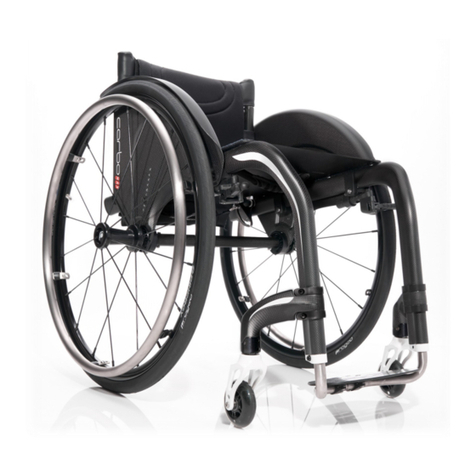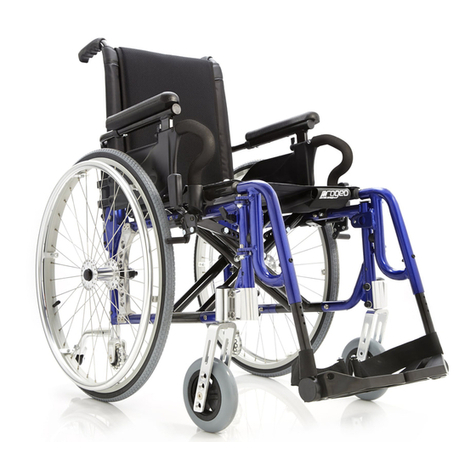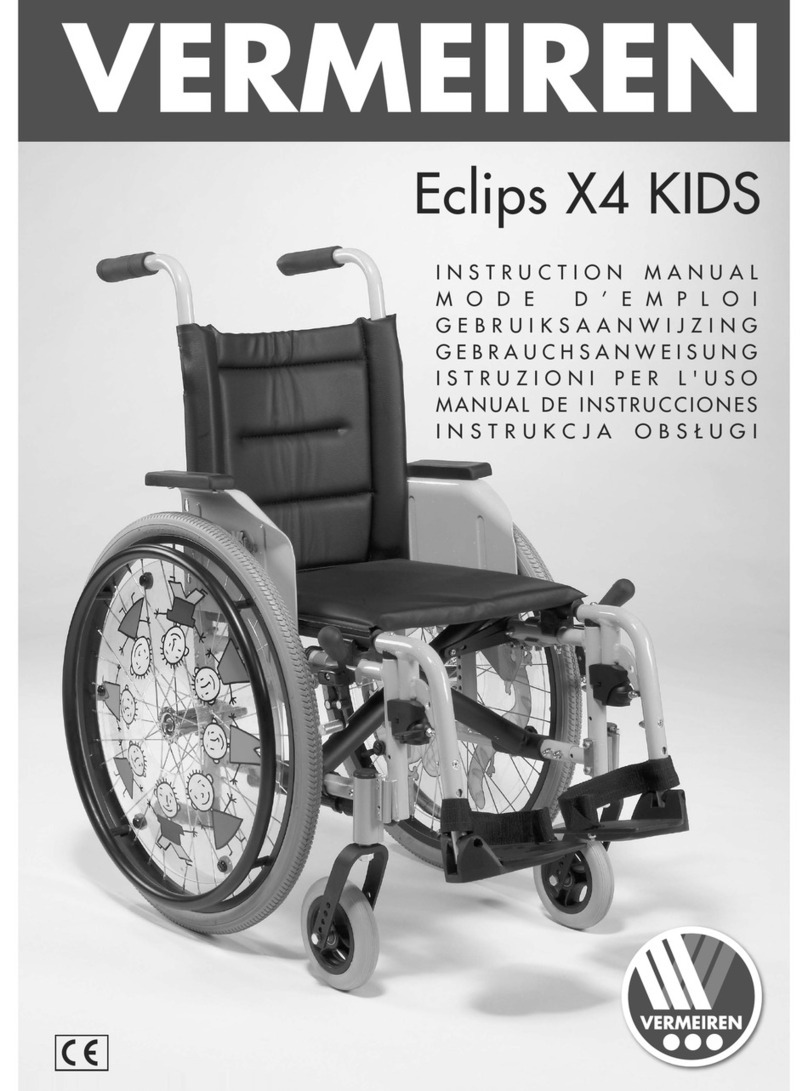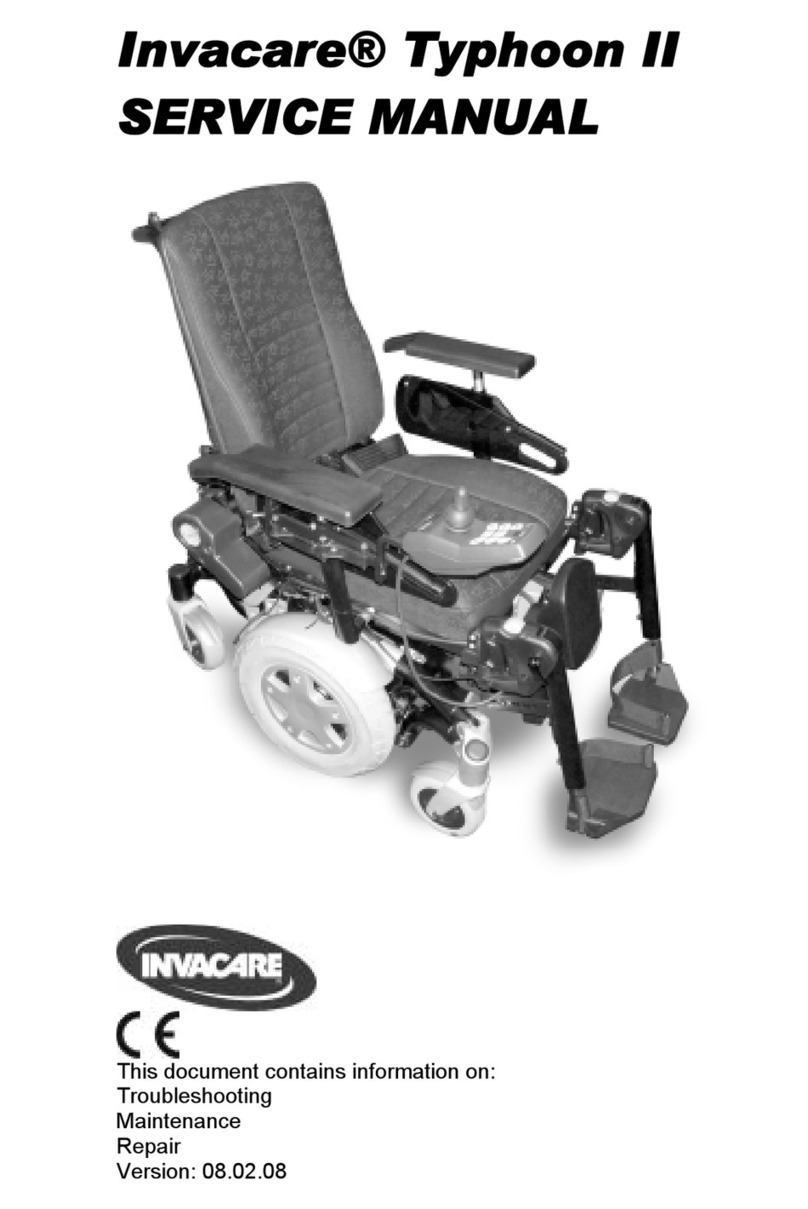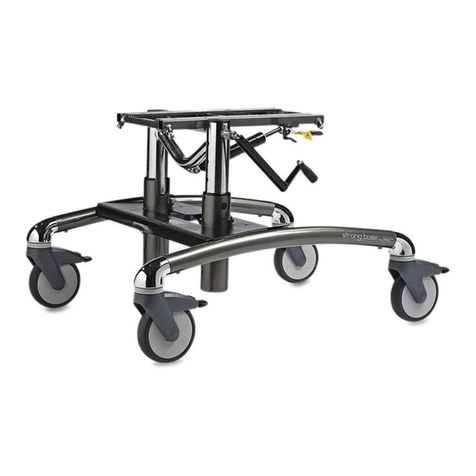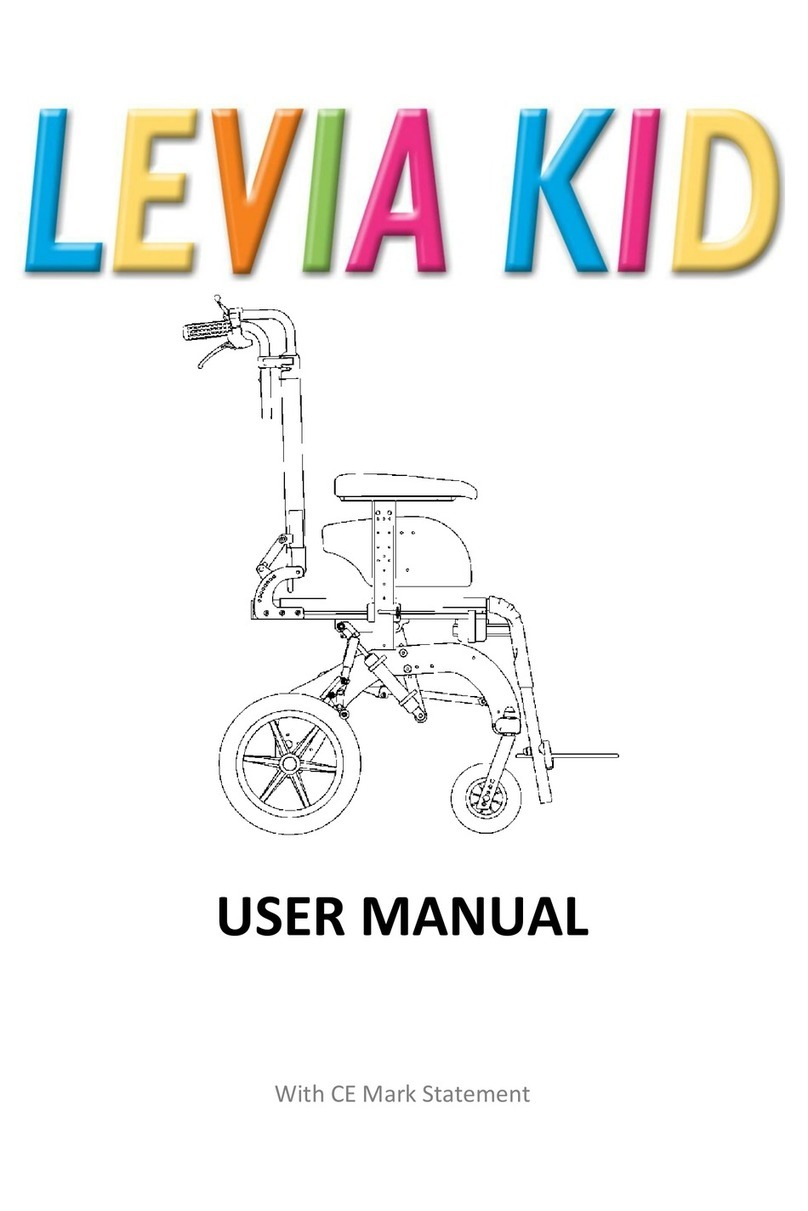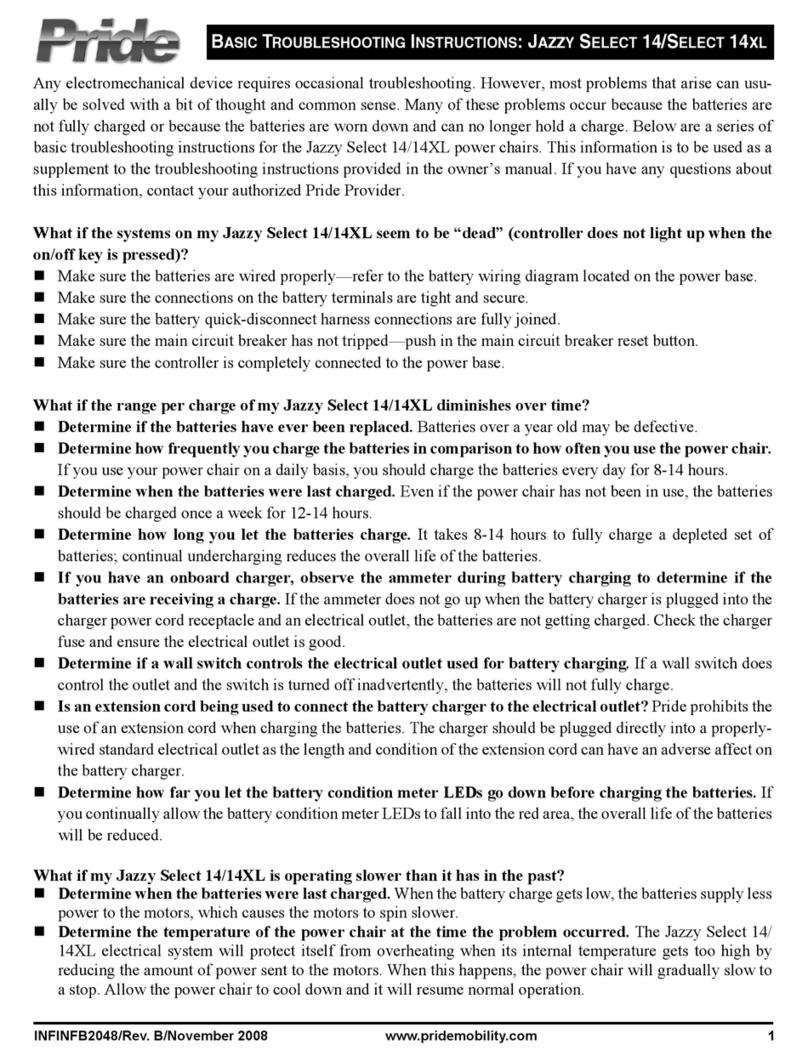progeo JOKER R2 User manual

REHATEAM s.r.l.—vicolo Negrelli 5—31040 Castagnole di Paese TV - www.rehateamprogeo.com Service Manual JOKER R2 1
S E R V I C E M A N U A L
JOKER R2
Rev. 0 - 06/05/2020
SERVICE MANUAL
ENGLISH

REHATEAM s.r.l.—vicolo Negrelli 5—31040 Castagnole di Paese TV - www.rehateamprogeo.com Service Manual JOKER R2 2
SERVICE MANUAL
JOKER R2
GENERAL WARNINGS
ANY ADJUSTMENT CAN BE CARRIED OUT EXCLUSIVELY BY QUALIFIED
AND AUTHORIZED BY REHATEAM® PERSONNEL.
It is forbidden to carry out any modifications, even when possible, to the original
design.
Any adjustments and/or any modification that is carried out by non-authorized
personnel will immediately void the warranty on the product and it relieves
RehaTEAM® from any responsibility on any malfunctioning and/or damage due
to such adjustments/modifications.
Always contact RehaTEAM® and its technicians for any non-standard
requirements or modifications to allow them to evaluate such modifications and
verify that they will not compromise the normal and safe use of the wheelchair.
Any modification of the original parameters and set up could seriously
compromise the safe operation of the wheelchair causing damage to both the
user and the wheelchair itself.
After every adjustment made to the wheelchair, check carefully that all parts are
correctly fixed. Check that all screws and nuts are tightened and that all moving
parts are functioning correctly.
After any adjustment, always test the wheelchair before giving the product to
user and/or his/her attendant.
RehaTEAM® disclaims any responsibility for damage to the product or the peo-
ple due to any modification that is not properly performed or that, in any case,
does not guarantee safety to the user.

REHATEAM s.r.l.—vicolo Negrelli 5—31040 Castagnole di Paese TV - www.rehateamprogeo.com Service Manual JOKER R2 3
SERVICE MANUAL
Page adjustment
04 FRONT HEIGHT Caster on fork
05 FORK ANGLE Fork support V-Design
06 DIRECTIONALITY
08 REAR HEIGHT Standard rear unit
09 REAR HEIGHT Full Carbon side plates
10 SETTING (point of balance) Standard rear unit
11 SETTING (point of balance) Full Carbon side plates
12 CAMBER AND CONVERGENCY
14 BRAKE
15 BRAKE SPACING
16 SIDE GUARD Standard rear unit
18 REMOVABLE SIDE GUARD Standard rear unit
20 FOOTPLATE DISTANCE tubes with holes
21 FOOTPLATE DISTANCE sliding system (until 2018)
22 TUBULAR ALUMINIUM FOOTPLATE
23 ALUMINIUM FOOTPLATE WITH CURVED TUBES
24 ALUMINIUM FLIP-BACK FOOTPLATE
25 CARBON FIBRE FOOTPLATE
26 “U” TUBE ALUMINIUM FOOTPLATE
27 BACKREST HEIGHT Aluminium or titanium backrest
28 BACKREST HEIGHT Carbon fibre backrest
29 BACKREST ANGLE
30 SEAT WIDTH ENLARGEMENT
31 QUICK RELEASE AXLE (rear wheel)
JOKER R2

REHATEAM s.r.l.—vicolo Negrelli 5—31040 Castagnole di Paese TV - www.rehateamprogeo.com Service Manual JOKER R2 4
FRONT HEIGHT
caster on fork
The entity of the adjustment obviously depends on the caster and fork’s sizes.
Screw off the bolt Vwhile holding the other.
Remove the axle P.
Position the caster to another hole, insert the axle and fix the bolt Vholding the one
on the other side.
Pay attention to the spacers between caster and fork.
SERVICE MANUAL
V
V
P
It is advisable to spread a
drop of mild lock thread
glue on the bolts V.
Fork
height
Holes intervals –12,7 mm
Sport –2 holes –h. 88
Piccola –3 holes–h. 112

REHATEAM s.r.l.—vicolo Negrelli 5—31040 Castagnole di Paese TV - www.rehateamprogeo.com Service Manual JOKER R2 5
SERVICE MANUAL
It is advisable to pread a
drop of mild lock thread
glue on all grab screws G.
WORK ON A FLAT AND EVEN SURFACE
Whenever the seat height is changed or as periodic maintenance, check the fork angle and, if necessary, adjust it in order to have the fork
axis perpendicular to the ground.
The adjustment is possible by means of the four grab screws G1, G2 and G3 that make the axle Pturn on the fulcrum F.
P
To turn the fork
frontward
Loosen G2.
Screw G1 and G3
Perpendicularity
You can check the perpendicu-
larity with the help of a square
(or similar) vertically aligned to
the caster turned 90° with re-
spect to the driving direction of
the wheelchair
To turn the fork
backward
Loosen G1 and G3
Screw G2
To adjust the fork, once you know the direction (frontward or backward) towards which it is necessary to move the fork’s axle, proceed as
above-mentioned until reaching the correct angle.
You can also measure the perpendicularity by turning the fork by 360°: during the full turn, the wheel has to touch the surface in all posi-
tions.
If a headless bolt results hard to unscrew, DO NOT FORCE IT, but try to loosen the other two first.
If the fork’s axle (the axle P) results hard to move, slightly loosen the bolt of the fulcrum F(remember to screw it after adjust-
ment).
Once you reach the correct angle, screw all three headless bolts all the way down to the axle P, but without tightening.
In order to fix the system, tighten first one and then the other less than a quarter of a turn at once, the grab screws G1 and G2 (the front
ones) checking the perpendicularity; in fact, it may slightly change during this phase.
Should that happen, correct the angle proceeding in the same manner.
When you have tightened both headless bolts G1 and G2, you can tighten the headless bolt G3.
Check the perpendicularity again and, if necessary, correct it.
FORK ANGLE
90°
F
G3
F
G1
G2
G1
F
G2 G3
P
Rotation when
screwing
G1 and G3
Rotation when
screwing
G2 and G3
G2
G1
G3
G1
F
G3
G2

REHATEAM s.r.l.—vicolo Negrelli 5—31040 Castagnole di Paese TV - www.rehateamprogeo.com Service Manual JOKER R2 6
SERVICE MANUAL
DIRECTIONALITY
A very important aspect of any wheelchair is its directionality.
To check if the wheelchair goes straight, sit on it, push it and let it go until it stops.
If something is wrong, the slower the wheelchairs moves forward (momentum close to nothing), the more likely it turns right or left. There-
fore, if no or irrelevant turn occurs, the wheelchair is properly adjusted.
Cause Reason Solution
SURFACE The surface where the test is being performed is not even
and flat
Test the chair on even and flat surface
REAR WHEELS
The rear wheel are not equally inflated Inflate both tyres at the same pressure
The tyres of the two rear wheel are different or differently Change the tyres
The rear wheels are not adjusted at the same height Adjust the rear wheel height
The camber of right and left wheels are different or differ-
ently adjusted
Adjust the camber.
The wheel, when turning, touches the side guard or the
brakes
Fix or replace the side guard. Add spacer on the
receiver. Adjust the brake.
The wheels doe not turn smoothly Clean or change the bearings
FRONT WHEELS The casters are not adjusted at the same height Adjust the front wheels at the same height
The tyres of the two front wheels are different or differently Change the wheels
The fixing bolts of the fork/fork support/clamp are loosened Check and tighten all fixing bolts
The caster does not turn smoothly Clean the bearings.
Either or both forks are not adjusted so as their axis is per-
pendicular to the ground.
Adjust the fork axis inclination.
FOOTPLATE The footplate tubes are adjusted at different height. Adjust the tubes at the same height
If the wheelchairs does not go straight, in most cases the reason
is the fork angle adjustment.
However, before working on the fork angle adjustment, check all
the points above mentioned.
First, make the test along a flat even surface to check the direc-
tionality.
1 The correct adjustment has both forks perpendicular to the
ground, that is, their axis at 90°.
2 If the wheelchair TURN RIGHT, the cause is one or more of
the following:
The RIGHT fork is tilted inwardly and/or backward
The LEFT fork is tilted outwardly and/or frontward
3If the wheelchair TURN LEFTT, the cause is one or more of
the following:
The LEFT fork is tilted inwardly and/or backward
The RIGHT fork is tilted outwardly and/or frontward
90° 90° 90° 90°
1
2
3
Follows next page

REHATEAM s.r.l.—vicolo Negrelli 5—31040 Castagnole di Paese TV - www.rehateamprogeo.com Service Manual JOKER R2 7
SERVICE MANUAL
DIRECTIONALITY
ADJUSTING THE DIRECTIONALITY
Check that the two forks are perpendicular to the ground. If they are not,
proceed with the adjustment of the fork angle following the instructions
on the sheet FORK ANGLE ADJUSTMENT.
If both forks axis are correct but the wheelchair still turns right or left, it
means that the latitudinal angle is not perfect.
This may be due to hit, to improper pressure exercised on the fork or its
support, or to a tiny imperfection among all parts fixed together due to
their manufacturing tolerances.
You can fix the fork axle P in three different angles to correct the direc-
tionality.
Loosen all four grab screws G, remove the bolt Fand slide off the fork
complete with the axle P.
The axle has two side hollows Bwhere you have to cast the flat inserts
C0 or the 1° titled inserts C1 that are recognizable thanks to two dots.
With the flat inserts C0, the axle keep its original inclination.
With the tilted inserts C1, the axle tilts by 1° right or left according to
how to cast them in the hollows—see images.
Note: you can cast the inserts only as indicated in these images.
Once you have casted the inserts C0 or C2, it is advisable to try to
screw the bolt Fto check there is no difficulty. Sometimes, in fact, the
holes of the inserts may have working burr that make the bolt hard to go
through.
To mount the fork unit. Insert the axle Pin the fork support paying atten-
tion to the orientation of the same axle. In fact, the axle is not straight,
but it shows a bend. Such bend must be facing to the rear of the wheel-
chair.
Insert and screw the bolt Fwithout tightening it much (it is enough to screw it up to stop).
Adjust the fork angle —see sheet “fork angle”.
Note. This type of adjustment can take place even at original assembly, therefore, you may find the in-
serts C0 on one axle and C1 on the other, for instance.
The wheelchair is not supplied with supplementary inserts, therefore, it will be necessary to order them
when needed.
Axles without inserts
Until 2019 the axles had no inserts C0 or C1. There were 0°, 1°rh and 1°lh axles.
To adjust the directionality, it is necessary to change the axle.
B
P
0° XY1°
Y X X Y
X Y Y X
0° 1° 1°
P P P
C0 C1
F
G3
F
G1
G2
SIDE VIEW
P
FRONT REAR
C0 oC1
P
C0
or
C1
C0
or
C1

REHATEAM s.r.l.—vicolo Negrelli 5—31040 Castagnole di Paese TV - www.rehateamprogeo.com Service Manual JOKER R2 8
SERVICE MANUAL
REAR HEIGHT
STANDARD REAR UNIT
When decreasing the rear height it is necessary to remove the mudguard first, fact, the tyre will
touch it and it will impede the adjustment. With fixed mudguards, you need to remove bolts V1 and
V2. With removable mudguard, just pull it off. If the side guard is straight, leave it where it is.
Loosen the grab screw Bon the rear lower side of both clamps A.
Loosen the bolt Cof both clamps A.
Now you can slide the two clamps Aalong the posts E.
Should the clamps be hard to slide, loosen the bolts B and C and/or, with care, hit them with a mal-
let to the necessary direction. Such operation may result particularly useful for the final adjustment
when the necessary movement is very little.
The rear axle D always remains fixed to the clamps A.
The grab screw Xand the bolt Yare not involved is this adjustment.
Slide the system to the necessary height.
Fix the clamp Aof either side, tightening the bolt Chard and then tighten the grab screw B.
Before fixing the other side, check the height is the same.
To make sure that right and left side are at the same height, take measure from two “fix points”, for
instance: straight line from the hole of the post where side-guard fixing bolt V2 is fixed (with remov-
able side guard, this hole is free) to the upper side of the clamp A, or from the clamp Ato the mid-
dle of inner plate F of the clamp that holds the frame.
When changing the rear height it is necessary to modify the mudguard. However, if the side-guard
is straight you may leave it as it is, its upper edge will be lower or higher with respect to the tyre.
To remove and adapt the side guards, follow instruction of sheet “side guard adjustment”.
In presence of anti-tipper support, the bolt Cis different; in fact,
it is involved in the support’s assembly. To proceed with the
height adjustment, remove the nut G, loosen the two bolts H
and move the support away from the bolt C.
Now you can loosen the bolt Cand continue the adjustment as
above explained.
To re-assemble the support, slide it in along the bolt Cchoos-
ing the one of the 4 holes and check which one give you the
best inclination of the anti-tipper. Then fix it with the nut Gand
finally tighten the two bolts H.
Remember that the rear height adjustment can affect the seat inclination, thus, it is necessary
to check and adjust the fork angle.
It is advisable to spread a drop
of mild lock thread glue on the
on the grab screws B.
C G
H
H
B
X
E
A
D
V1 V2
A
E
C Y
A
D
Hole for V2
F

REHATEAM s.r.l.—vicolo Negrelli 5—31040 Castagnole di Paese TV - www.rehateamprogeo.com Service Manual JOKER R2 9
SERVICE MANUAL
REAR HEIGHT
FULL CARBON SIDE PLATES
Adjustment every 1 cm.
Remove the bolt Aon both sides of the wheelchair. The inner plate of the clamp-
support Band the nut will come off.
Move the frame up or down until aligning the hole of the support B(not visible in the
picture because it lays between the plate and the frame, but it is indicated by the
dotted rectangle) with one of those of the plate C.
Then insert the bolt A, the inner plate and the nut in its location.
When tightening this bolt, check that the inner plate of the clamp does not turn (you
can hold it with your fingers), in fact, if it turns, the clamp will not take hold of the
frame properly.
Finally tighten the bolt.
There is no need to use a spanner to hold the nut; in fact, its location on the inner
clamp will hold it.
Check/adjust the brakes.
Remember that the rear height adjustment can affect the seat inclination, so it is
necessary to check and adjust the fork angle.
The rear height adjustment can also change the point of balance (setting) of the
wheelchair.
If necessary, adjust the setting.
You will never need to modify the side guard.
Part leaning
against the plate
Inner
plate
B
A
B
C
A
Inner plate
of the clamp B
Nut
Part of the clamp B
leaning against the plate

REHATEAM s.r.l.—vicolo Negrelli 5—31040 Castagnole di Paese TV - www.rehateamprogeo.com Service Manual JOKER R2 10
SERVICE MANUAL
SETTING (point of balance)
STANDARD REAR UNIT
E
D
A
A
B
A
C (V2) C
V1
F Front clamp F
Axle with threaded rivet fixing with nut
X
A G
(V2)
Thanks to a sliding system, you can adjust the setting of the wheelchair every millimetre.
Remove the bolt/washer V2 and swing the side guard up until you can get access to the clamp Aof
the post B.
Loosen the two grab screws Cof the clamp A.
Loosen the bolt Dand the two nuts Ethat you find on the inner side of the clamp A.
Repeat the same operation on both sides of the wheelchair.
Loosen the bolt V1 that fixes the front clamp Fthat is also the brake support, of both sides of the
wheelchair. Note: the bolt is screwed into a threaded rivet fixed to the front axle, or, if the front axle is
not present, that bolt is screwed into a nut.
Slide the clamps Afrontward or backward along the frame. If the tyre touches the brake, move
the front clamps forward. It may be possible to scratch the frame, so it is advisable to proceed
with care without forcing the system.
Once you reach the necessary setting, tighten the two nuts Efirst, then the bolt Dand finally
the grab screws Cof one clamp A.
Before fixing the other side, make sure the two clamps are at the same distance.
A good reference point is the distance X, from the rear side of the clamp Ato the bolt Gthat
fixes the backrest plate.
It is advisable to spread a drop
of mild lock thread glue on the
on the grab screws B.
Now, swing the side guard down and slide it along the frame (the front clamps are still loosened) until aligning the hole with the threaded
one of the clamp and fix it with the bolt/washer V2. WARNING: fit the bolt V2 with care to prevent damaging the thread of the threaded hole.
Repeat the same operation on the other side and finally fix the bolt V1 of both sides.
The fixed side guard does not need any modification; on the other hand, the removable side guard will have
to be adjusted (see sheet “side guard adjustment”). You do not need to adjust the brakes.
The predetermined settings that appear in the order form have the following distance S(from the backrest’s
axis to the wheel’s axis):Prudential 9.0 cm; Standard 10.5 cm; Active 12.0 cm; Extreme 13.5 cm.
Following the instruction above, you can reach a particularly prudential setting approx. 5 cm (distance X= 0,
rear clamp in contact with the backrest plate).
Remember that the setting adjustment can affect the
seat inclination, so it is necessary to check and adjust the
fork angle.
V1 V2
S

REHATEAM s.r.l.—vicolo Negrelli 5—31040 Castagnole di Paese TV - www.rehateamprogeo.com Service Manual JOKER R2 11
SERVICE MANUAL
SETTING (point of balance)
FULL CARBON SIDE PLATES
Loosen the bolt Cof the rear clamp Don both plates.
Slide the frame frontward or backward through the clamps to the desired position.
If the frames are too hard to move, loosen the bolts as much more as it is necessary.
It may be possible to scratch the frame, so it is advisable to proceed with care without
forcing the system.
It is possible to adjust the setting every millimetre.
Once reached the desired setting, tighten the bolts Aand Con one side first. Then,
from the inner side of the frame, measure the distance Xbetween the rear side of the
rear clamp and the backrest plate. Adjust and fix the other side respecting the same
distance.
When tightening each bolt, check that the inner plate of the clamp does not turn (you
can hold it with your fingers), in fact, if it turns, the clamp will not take hold of the frame properly.
Remember that the setting adjustment can affect the seat inclination, so it is necessary to check and adjust the fork angle.
The predetermined settings that appear in the order form have the following distance S(from the backrest’s
axis to the wheel’s axis):Prudential 9.0 cm; Standard 10.5 cm; Active 12.0 cm; Extreme 13.5 cm
Following the instruction above, you can reach a particularly prudential setting approx.
5 cm (distance X= 0, rear clamp in contact with the backrest plate).
A
B
A
BFront clamp B
Axle with threaded rivet fixing with nut
B
D
C
X
D
S
A
C
Remove the rear wheel.
Loosen the bolt Aof the front clamp Band put the wheel back on.
Note: the bolt is screwed into a threaded rivet fixed to the front axle, or, if the front axle is not present, that bolt is screwed into a nut.
Repeat the same operation on both sides of the wheelchair.

REHATEAM s.r.l.—vicolo Negrelli 5—31040 Castagnole di Paese TV - www.rehateamprogeo.com Service Manual JOKER R2 12
SERVICE MANUAL
CAMBER AND CONVERGENCY
The hole of the cambered receiver, since it is inclined, is not centered.
Therefore, check the wheel receiver its narrow edge looking upward and its wider edge down. If opposite, the convergence is oppo-
site, too (the wheels are opening apart at top!).
At 30 cm from the floor, take the measure centre-to-centre between the two tyres in front and at rear.
If the two measures are equal or the front one is slightly narrower (max. 5 mm), you have a good convergence as drawing 2 or 3.
If different, you have to adjust the convergence.
Se differente, è necessario regolare la campanatura.
Follows next page
WORK ON A FLAT AND EVEN SURFACE
The wheel receiver gives the rear wheel camber (cambered receiver).
The two wheel receivers are fixed to the rear axle, thus, to adjust the convergence, it is necessary to turn the axle.
The drawing 1shows same inclination (camber) of both rear wheels.
With cambered wheels, it is necessary to check/adjust the convergence, the distance between the two wheels in front and at rear.
The drawing 2 shows the aerial view of the wheels and the front distance DA is equal to the rear distance DP, while the drawing 3,
DA is narrower than DP by maximum 5 mm.
We can say that a good convergence has the front distance DA equal to or slightly narrower than the rear distance DP.
DA must not be wider than DP. In such case, the fluency of wheelchair will not be good.
RECEIVER
Narrow side up
Wide side down
30 cm
FRONT REAR
DA DP

REHATEAM s.r.l.—vicolo Negrelli 5—31040 Castagnole di Paese TV - www.rehateamprogeo.com Service Manual JOKER R2 13
SERVICE MANUAL
CAMBER AND CONVERGENCY
Take the measures again and if necessary, repeat the same operation until you reach the correct conver-
gence, se previous page.
If the clamp moved when you loosened the fixing bolts, position the axle’s end (not the receiver) at 8 mm
from the clamp for the standard rear unit, or 5 mm if Full Carbon plate and fix one side, first.
Standard rear unit: tighten the bolt A and then the grab screw B.
Full Carbon side plates: first tighten the two bolts Balternatingly and then the bolt/nut C. Warning: if you
reverse that sequence, the lock plate may crack it its thinner part. Finally, screw the grab screw A.
Before fixing the other side, check the front wheels (considered already adjusted at the same height) are
both touching the ground. If one do not touch, turn the frame on axle on its loosened side to the necessary
extent.
If the quick release axle of the rear wheel hardly or do not pass through the receiver, loosen A, B (and C)
and remove it. Then, tighten all parts again, but first pass the hole with a ½” reamer to remove any possible
tiny deformation (see also adjustment sheet “quick release axle”).
It may be a little harder to position and fix the other side due to the pressure given by the seat canvas, but
you have to respect the same distance.
Check the measure from a fix point of the frame to the centre of the tyre on each side. Should there be a
difference greater than 2-3 mm, check the distance between clamp and axle as above mentioned.
If necessary, correct the adjustment.
2
1 3
2° receiver
4° receiver
Standard rear unit: loosen the bolt Aand then the grab screw B. The grab
screw Cis not involved in this adjustment.
Full Carbon side plates: loosen the grab screw A and the bolt/nut C.
Loosen the above mentioned screws just enough to let you turn the rear axle with your hand but without the clamp
sliding along the axle. If that occurs, you can continue with the adjustment. You will fix that later.
Turn the rear axle (clockwise or anticlockwise) and observe how and to what extent the wheels move.
A good reference is the bolt D, in fact its axis, should be perpendicular to the ground, except for the 4° receiver
fixed in the centre position (2) which is rotated by 90° with respect to the other two positions (1 and 3); in such
case, the bolt D should be parallel to the ground.
Thinner side of the lock plate
8 mm
D
A
B
B
CC
Standard rear unit Full Carbon side plates
A
B
C
5 mm
D

REHATEAM s.r.l.—vicolo Negrelli 5—31040 Castagnole di Paese TV - www.rehateamprogeo.com Service Manual JOKER R2 14
SERVICE MANUAL
BRAKE
WHEN ADJUSTING THE BRAKES, THE TURES MUST BE INFLATED TO THE CORRECT PRESSURE (except solid tyre)
The position of the brake depends on the position of the rear wheel.
Loosen the headless bolt Alocated in the lower side of the support B.
Position the brake-knurled rod Pat a distance Dof a few millimetres and parallel to the ground.
Temporarily tighten the headless bolt Aand try the brake out to check if the adjustment is good.
If necessary, repeat the same operation to reach the good adjustment.
A good adjustment has the brake not too hard to engage but braking, so you will have to find the suitable compromise.
Once reached the correct position, tighten the headless bolt A.
Carry out the same operation on the other side.
The adjustment for the sport brake is the same except for the
distance D, in fact, the brake, in its resting position is far away
from the tyre. Just make a few tries
Note: if the frame s rather short (short seat depth) there may be interference with the front curve of the frame. In that case, it is necessary to
move the rear wheel backward (point of balance) as much as necessary (see adjustment sheet ”setting”)
B
A
A

REHATEAM s.r.l.—vicolo Negrelli 5—31040 Castagnole di Paese TV - www.rehateamprogeo.com Service Manual JOKER R2 15
SERVICE MANUAL
BRAKE SPACING
B
Spread
some strong
thread lock
glue on the
bolt B.
In several cases, the distance between the tyre and the frame can be such
as to make need moving the knurled rod Pmore external.
When originally assembling the wheelchair, such possible modification is
already taken into account.
In case of a post-sale modification that results in the rear wheels being
more external (from 0° to 2° or 4° camber; seat width enlargement; a dif-
ferent wheel), the brake may not work efficiently anymore, therefore, you
will have to move the knurled rod. The brake is efficient if the knurled rod P
is at least 5 mm beyond the tyre’s mid-line.
In all cases, check the brake efficiency.
Remove the bolt B. In order to remove it, put the knurled rod in a vice and heat it with a hot air blower because the bolt is locked with strong
lock thread glue. DO NOT FORCE WHEN UNSCREWING IT, you may damage the bolt’s head irremediably.
Once you have removed the bolt, the knurled rod comes off, too. Replace the bolt Baccording to the spacer C(7 or 11 mm) you will add.
Put some strong lock thread glue on the bolt Band assemble the spacer Cand the knurled rod A.
Put the knurled rod in a vice and tighten the bolt B hard.
It is also possible to move the brake structure Efrom the adjustment rod F.
Remove the two nuts Gand then the two bolts B.
Remove the spacers Haround which the spring is assembles.
Observe how the spring is assembled because you will have to assemble it back later in
the same way (you can always have a look at the other brake that is symmetric).
Insert the spacers H(H1= original; H2= 7 mm longer).
Position the spring and assemble the structure to the adjustment rod.
Start screwing the two bolts Ball the way down and then the two nuts G.
Should the brake movement be hard, slightly loosen the bolts B.
E F
G
B

REHATEAM s.r.l.—vicolo Negrelli 5—31040 Castagnole di Paese TV - www.rehateamprogeo.com Service Manual JOKER R2 16
SERVICE MANUAL
SIDE GUARD
STANDARD REAR UNIT
Whenever changing the rear height, you have to adjust the side
guard. If the side guard is straight, you may leave it as it is.
The side guard should be adjusted at approx. 5 mm from the tyre
and it is fixed to the front frame with the bolt/washer V1 and to the
adjustment post with the bolt/washer V2.
Each side guard is shaped to measure according to the configura-
tion of the wheelchair when originally assembled.
The shape of the side guard always allow for a reasonable good
margin of adaptation.
Bolts fixing
The bolt/washer V1 is screwed into a threaded rivet fixed to the front
axle A. when removing this bolt, the front clamp, made of the inner
plate B and the brake support C(with the brake fixed to it), comes
off the frame (if the axle turn when unscrewing V1, hold it with one
hand). Note: with the carbon fibre rigid seat, the axle is not present
and the bolt is fixed with a nut.
To assemble the parts, let the bolt/washer V1 through the hole of the side guard and through the hole of the brake support C.
Position the support C on the frame.
Position the plate Band screw the bolt V1 into the axle A. Make sure the axle is cast into the housing of the plate.
While screwing the bolt V1, hold the axle Aso that it will not turn and make sure the plate Bis well leant against the frame.
V1 V2
5mm
V1
A B C
fixing with nut
Hole for V2
D
C
V1 B
C
A B
A
To fix the other side, the operation is quite the same, but
it is advisable to insert the axle Ainto the housing of the
plate Band lean it against the frame before positioning
the support C.
This operation may need a little forcing due to the pres-
sure given by the seat canvas.
Finally, tighten the bolt V1.
The bolt V2 is fixed to the threaded hole of the
clamp Dof the adjustment post.
Take care when fitting the bolt V2 with care to
prevent damaging the thread of the threaded hole.
Follows next page
B
A

REHATEAM s.r.l.—vicolo Negrelli 5—31040 Castagnole di Paese TV - www.rehateamprogeo.com Service Manual JOKER R2 17
SERVICE MANUAL
SIDE GUARD
STANDARD REAR UNIT
When changing the setting (point of balance), it is not necessary to modify the
side guard, see also adjustment sheet “setting”.
When increasing the rear height, you have to lower the side guard and bring it to
approx. 5 mm from the tyre and parallel to it.
After the adjustment, put the rear wheel on and measure the distance Xbetween the
mudguard and the tyre. From that measure, take off 5-6 mm. The result will be the
measure you will use as reference to mark the point where to drill the new hole for
the bolt V2.
Example: if X= 31 mm; 31 –6 = 25; the new hole will have to be 25 mm above the
existing one.
To mark the point, you can use a ruler. Position it parallel to the adjustment post and
aligned with the axis of the bolt V2.
The distance centre-to-centre between the two holes must not be lower than 10 mm.
If the necessary adjustment is less than 10 mm, you should drill the new hole at top
right or top left until the two holes will be 10 mm from one another.
Remove both the bolt V2 and V1.
Remove the side guard and drill a 6 mm hole where you marked for the V2.
On the front inner side of the sideguard, in order to make marking the point easier,
you can put some sticky paper tape. Assemble the sideguard with V2 and position it
at 5 mm from the tyre and parallel to it.
While holding the support Cwith the brake well leant against the frame, mark with a
point, a pencil or else, where you will have to drill the new hole.
Check that the point you marked is not too close to the edge of the side guard or to
existing hole. In either case, move the support a few millimetres away and mark the
point again.
Remove the V2, remove the side guard and drill a 6 mm hole where you marked it.
Mount the side guard fixing V2 and then V1.
Repeat the same operations for the other side guard.
When decreasing the rear height, you have to move the side guard up.
The adjustment is limited to the lower edge of the side guard.
Usually, the margin is approximately 15-20 mm. If the side guard is straight, you can
decide whether to modify it or not.
To mark the point where to drill the new hole, use a ruler likewise described above
and taking into consideration the entity of the adjustment.
Therefore, if the adjustment is 15 mm, the new hole will be 15 mm below the existing
one. If the adjustment is less, remember that the distance centre-to-centre between
the two holes has to be at least 10 mm.
Between the new hole and the edge of the sideguard there must be at least 3 mm.
When changing both the setting and the rear height, proceed as if you are chang-
ing just the rear height.
X X
V2
min. 3 mm
min. 10 mm
Sticky paper tape
on front inner side
Mark the point where to drill the new hole
C
V1 V2
At each adjustment, spread some mild lock thread glue on the bolts V2.After the rear height adjustment, adjust, if neces-
sary, the brakes, too.

REHATEAM s.r.l.—vicolo Negrelli 5—31040 Castagnole di Paese TV - www.rehateamprogeo.com Service Manual JOKER R2 18
SERVICE MANUAL
REMOVABLE SIDE GUARD
STANDARD REAR UNIT
At each adjustment, spread some mild
lock thread glue on the bolts C and H.Follows next page
After every adjustment of
the rear wheel, you have to
adjust the position of the
side guard. You have to
adjust the side guard at
approximately 5 mm from
the tyre.
The side guard is fixed to
three points on the blade A
that slides in the support B
fixed to the frame.
A C
A
D
A
B
HEIGHT ADJUSTMENT
The blade Ashows, in its vertical side, a series of holes to fix the bolt Cthat inserts in the hollow Dof the support B. Therefore, to change
the height, just remove the bolt Cand screw it in another hole.
Warning: do not tighten the bolt C excessively: it may damage the threaded hole until making it unusable.
SIDE GUARD MODIFICATION
If one, the other or the combination of both adjustment above mentioned are not satisfactory, you can modify the side guard.
Every side guard is shaped to measure according to the configuration of the wheelchair when originally assembled.
The shape of the side guard always allow for a reasonable good range of adaptation.
Note: if the side guard is straight, you can decide to modify it or not.
A When you decrease the rear height, you have to move the side guard up.
1. Remove the three bolts Hto take the side guard off the blade.
2. Position the side guard at approximately 5 mm from the tyre, always leant on the blade A. The bolt Con the blade must be inserted in the
hollow Dof the support.
3. While holding this position, mark the point where it is necessary to drill the first new hole (1 or 2; 3 is usually not accessible with the rear
wheel on).
4. To do so, use a point and let it through the accessible hole. If the rear height adjustment is remarkable, you may need a new sideguard.
5. Drill a 5 mm on the sideguard where you have marked it.
6. Countersink the hole.
7. Insert and screw the bolt H.
8. To drill the second hole on the side guard, follow instruction from 3 to 7.
9. To drill the third hole, remove the side guard, mark the point where to drill and follow instruction from 5 to 7.
Advice for drilling. While drilling a hole, such hole may result slightly moved with respect to the precise point you marked. For the first hole,
that move does not cause any trouble. On the other hand, for the second and third hole, it may cause a non-alignment between hole on the
side guard and hole on the blade. A good method to be more precise, once you reach point 5, is to use a 4 mm drill pin (in order to avoid
damaging the thread of the hole on the blade) and drill the side guard. Then, use and let a M5 tap through the threaded hole of the blade
and out of the side guard.
H
D C
3
1 2
3
2
1

REHATEAM s.r.l.—vicolo Negrelli 5—31040 Castagnole di Paese TV - www.rehateamprogeo.com Service Manual JOKER R2 19
SERVICE MANUAL
SIDE GUARD
STANDARD REAR UNIT
At each adjustment, spread some mild
lock thread glue on the bolts C and H.
BWhen you increase the rear height, you have to move the side guard down.
X
B
If the lower side of the side guard is in contact with the support, it is necessary to cut it.
Measure the distance Xfrom side guard and tyre and subtract 5 mm (es: 18-5 = 13 mm to cut).
Remove the three bolts Hto take the side guard off the blade.
Draw the cut line according to the result you got.
Saw the side guard along the drawn line and round off the edges with a scissors blade or thin sand paper.
Continue with instruction A.
C When you change the setting, you have to move the side guard frontward or backward according to the new position of the rear
wheel, but the height of the side guard remains the same.
Proceed with instruction A.
D When you change both the rear height and the setting, you have to move the side guard up or down and forward or backward.
Continue with instruction A and, if necessary, instruction B, too

REHATEAM s.r.l.—vicolo Negrelli 5—31040 Castagnole di Paese TV - www.rehateamprogeo.com Service Manual JOKER R2 20
SERVICE MANUAL
FOOTPLATE DISTANCE
Tubes with holes
G
TUBE
TUBE
20 mm
fixing A fixing C
Rubber adaptor for round footplate tube on elliptical tube (from 2019).
The round footplate tube needs the adaptor Fto fit the elliptical frame tube. The adaptor’s hole is not centred, therefore, you have to pay
attention to mounting right and let adaptors in the same way.
• If the centre of the fixing hole Ais at 20 mm from the lower extremity of the frame tube, the adaptor Fis usually mounted with its narrower
side facing frontward. In order to avoid squeezing the adaptor too much, do not tighten the bolt very hard.
• If the centre of the fixing hole Ais further than 20 mm, thus even the hole C, the adaptor Fis glued to the frame and assembled with its
narrower side backward. This is due to the fact that when you tighten the bolt, the tube will lean against the inner side (which is very close)
of the frame tube and that guarantees the stability of the system. The bolt for this fixing includes a spacer Gunder the bolt’s head. This
way, the bolt will run in beyond the frame tube wall; if so, it would impede the correct fixing of the footplate tube. (This fixing is of course
also possible if the point Ais at 20 mm).
• To turn the adaptor, (if it is not glued), remove the footplate tube, slide the adaptor off and mount it reversed.
With elliptical footplate tubes, the adaptor is not present.
A
20 mm
B
A
Adjustment every 1.5 cm.
Remove the bolts Aand their corresponding washers and nuts B.
Slide the footplate tubes to the necessary height.
Make sure the two tubes are at the same height.
Insert and tighten the bolts.
After adjustment, check that between the lower side of the footplate and the ground
there is at least 2 cm and that there is no interference between footplate and casters.
Note: the part of the frame below the fork support, according to the requested
footplate distance, can be either 65 or, if the frame is cut, 20 mm long.
In both cases, the hole for the fixing bolt has to be 20 mm from the edge of the
frame so that it will correspond to the hole of the adaptor. If the frame is not cut
at origin, you can cut it off 45 mm afterwards. The 5 mm hole at the rear side is
pre-drilled, whereas you will have to drill an 8.5 mm hole on the front side.
To drill that hole, you have to be very careful to centre it with the frame’s axis as
well as the rear hole’s axis. It is advisable to mark the reference point before
cutting the frame; put a piece of sticky paper tape on the frame and, with a pen
or pencil, and draw the precise point, 65 mm from the edge, where to drill the
hole. Now, always paying attention to the centring, drill a 3 mm hole first, then 6
mm and finally 8.5.
20
65
45
20
45 Frame
cut
REAR FRONT
Other manuals for JOKER R2
1
Table of contents
Other progeo Wheelchair manuals
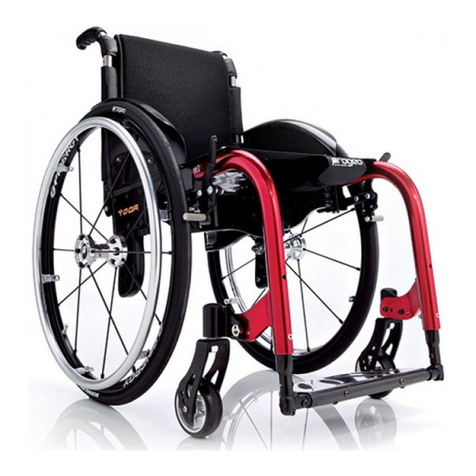
progeo
progeo YOGA User manual
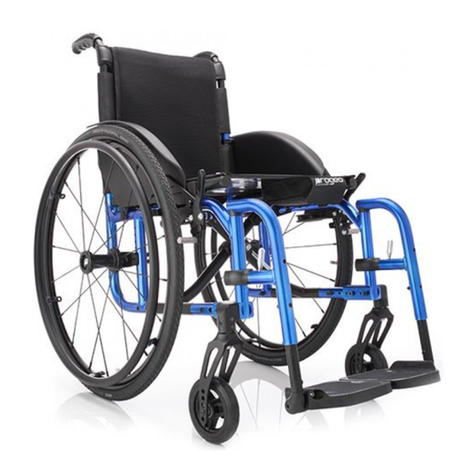
progeo
progeo Exelle User manual
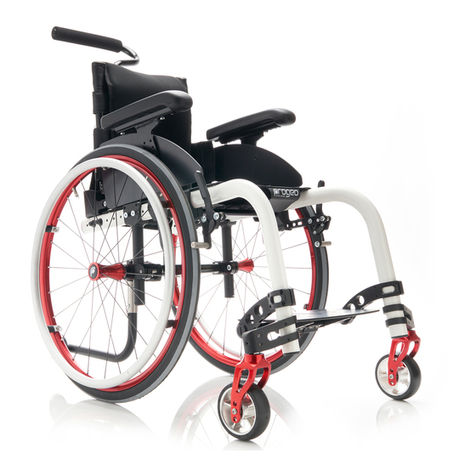
progeo
progeo Joker User manual
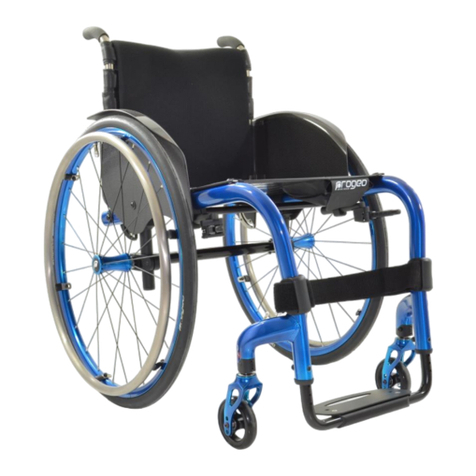
progeo
progeo JOKER R2 User manual

progeo
progeo ego User manual

progeo
progeo YOGA User manual
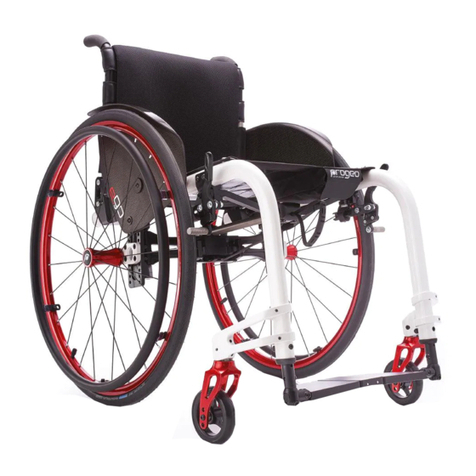
progeo
progeo EGO Series User manual
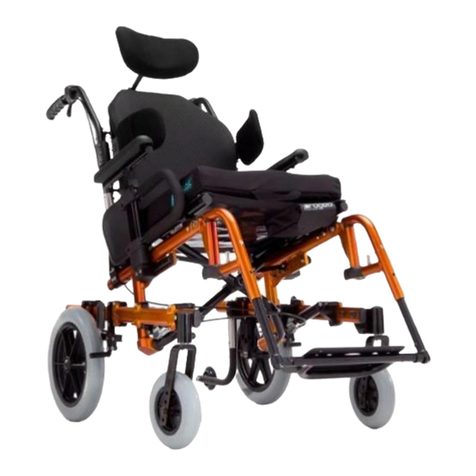
progeo
progeo Tekna Tilt User manual

progeo
progeo EXELLE VARIO Classic User manual
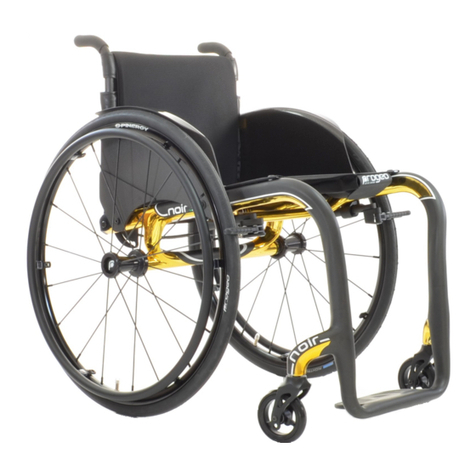
progeo
progeo NOIR 2.0 User manual
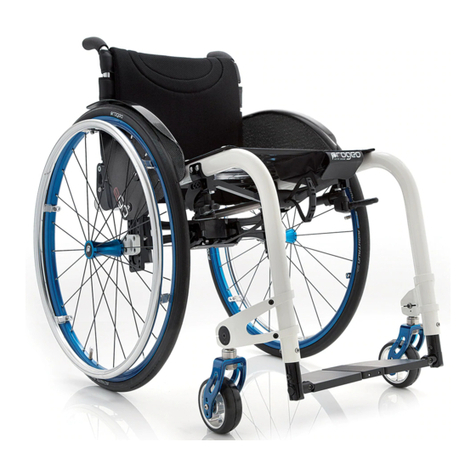
progeo
progeo ego User manual

progeo
progeo TEKNA TILT 2.0 User manual
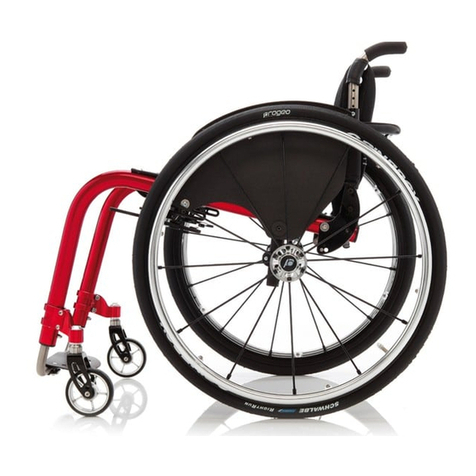
progeo
progeo JOKER EVOLUTION User manual

progeo
progeo Exelle User manual

progeo
progeo Exelle Junior User manual

progeo
progeo Tekna Tilt User manual
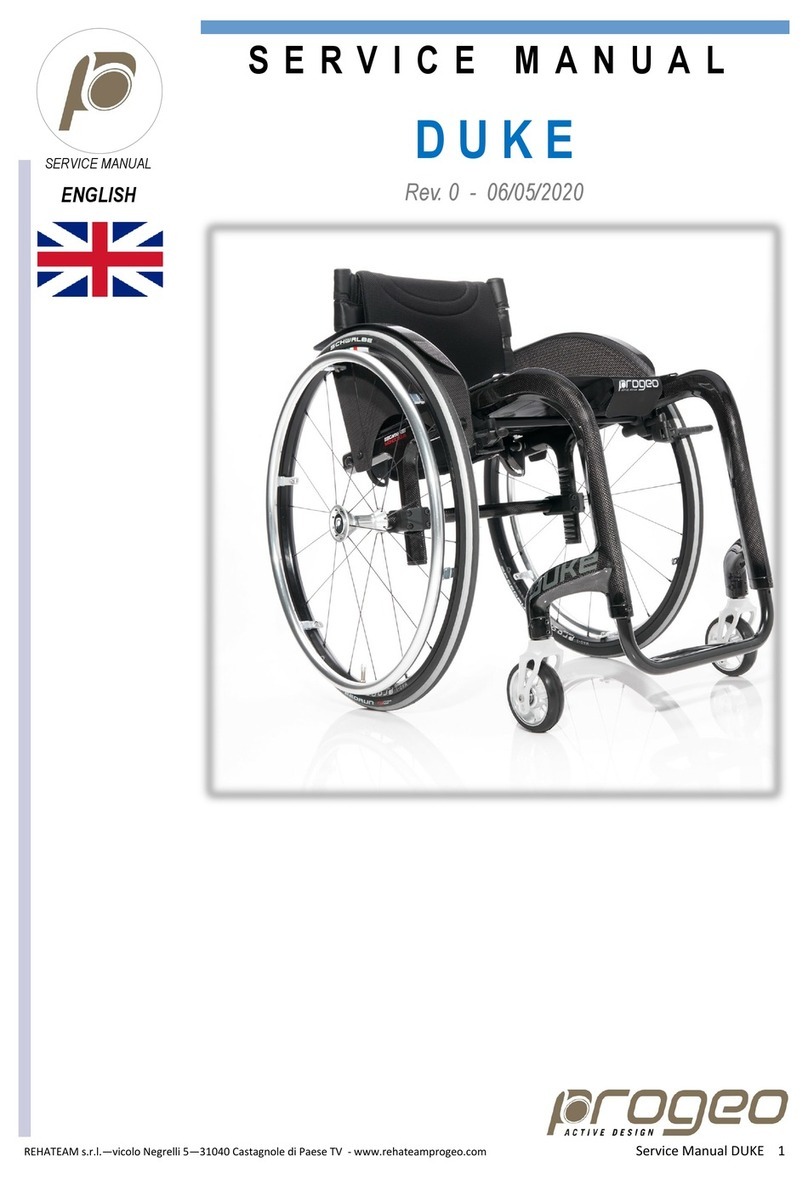
progeo
progeo DUKE User manual

progeo
progeo YOGA User manual

progeo
progeo VARIO CARBON User manual

progeo
progeo JOKER ENERGY User manual


